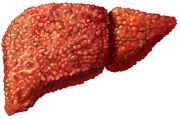Obeticholic Acid Shows Promise for the Treatment of Patients with Advanced Liver Disease
Study of farnesoid-x receptor agonist demonstrates protective effects on bacterial translocation from the small intestine in rat model of cholestatic liver disease.

Obeticholic acid, a bile acid analog and first-in-class agonist of the farnesoid X receptor (FXR), has been developed by Intercept Pharmaceuticals Inc. FXR, which is expressed in the liver and the intestine, belongs to the family of nuclear receptors, is essential to the regulation of lipids, glucose, and bile acid. FXR agonists have also been found to decrease portal hypertension in animal models of primary biliary cirrhosis (PBC). Obeticholic acid, which has received orphan drug status, is being developed for a variety of chronic liver diseases and patient populations including primary biliary cirrhosis (PBC).
PBC is an autoimmune liver disease that may progress to cirrhosis and liver failure, and it is currently the fifth-leading indication for liver transplant in the United States. Ursodiol is the only approved drug treatment for PBC and studies have shown that up to 50% of PBC patients fail to respond adequately, thereby remaining at risk of adverse outcomes.
Gut wall permeability (defects in the integrity of the intestinal wall) plays a key role in the pathogenesis of primary biliary cirrhosis and is highly regulated by the local expression of tight-junction proteins (such as Claudin 1 and 2 and Occludin and ZO1). These tight-wall junctions are affected by local and systemic inflammation.
Len Verbeke, PhD, of the Department of Liver and Biliopancreatic Disorders, KU Leuven, and his colleagues have been studying the effect of an FXR agonist on bacterial transportation, gut wall permeability, and the effects of systemic inflammation in cholestasis using rat animal models. They want to better understand the biological effects of FXR on the underlying biological processes involved in liver diseases like PBC.
Results from the study, still in proof of concept stage, were presented at the 2014 EASL International Liver Congress. Researchers compared 3 groups of animals: a control group, a group that had undergone common bile duct ligation, and a group of bile-duct ligated animals treated with obeticholic acid 500 mg/kg every 2 days. After 10 days the animals were tested for a) bacterial transportation (by culturing mesenteric lymph nodes and ascites in 8 different culture media), b) permeability (using Ussing Chambers that to allow researchers to determine tissue permeabilityand integrity of tight junction proteins in the gut wall), and c) systemic and intestinal inflammation.
Verbeke said, “The results showed a clear decrease in bacterial infection in animals that were treated with obeticholic acid; 5 out of 6 cultures (of mesenteric node) showed a significant decrease in bacterial infection in the treatment group.” The results also showed that obeticholic acid restored permeability to the ileum wall. He also noted “the expression of permeability inducing protein was also increased in the gut wall in animals treated with obeticholic acid which might mean that there is an increased permeability in the gut wall. However, this seems to be counter balance by the absence of Claudin-1 which regulates the tight-junctions.”
The obeticholic acid treatment group also showed reduction of white cells in the spleen as well as depletion of natural killer cells. “The depletion of natural killer cells is significant, because natural killer cells are the most important producers of interferon-gamma proteins, which induces increased intestinal permeability,” said Verbeke.
He said the important message of the study “is that obeticholic acid seems to works selectively in the ileum and reduces bacterial transportation, it restores intestinal permeability by showing very strong anti-inflammatory properties in the system and in the gut in the case of short-term cholestatic injuries.”